Sports Rehabilitation
Sports rehabilitation refers to healing an athlete after injury or following surgery. Our primary goal at Atlanta Orthopedic Institute PT is to get the athlete back to sport as quickly as possible.
Sports injuries are not fun. Physical therapy is proven to get the athlete back, sometimes better than before because we address the athlete as a whole and not JUST the area of pain or injury. Injuries seldom occur in isolation and often are caused my muscle imbalances
Respect must to be paid to the healing tissues. Injuries must be allowed time to heal as successfully as possible, before return to sport.
Sports Rehabilitation involves:
- Active Rest
- Correction of Motor patterns
- Restoration of joint Range of motion
- Exercise Progression
- Contributing factors
- Sports Team communication
- Active Rest
- Correction of Motor Patterns.
- Restoration of joint Range of motion
- Exercise Progression
- Contributing Factors
- Sports Team Communication
An athlete does not have to be completely inactive, while recovering from an injury.Instead, the athlete is guided in active rest - that is activities that allow the athlete to maintain strength and cardiovascular fitness, while allowing the injured tissues to continue healing. A Physical Therapist is uniquely qualified to help with this due to our comprehensive understanding of the recovery process, stages of tissue healing and our encyclopedic knowledge of exercises.
When a person is injured, their movement patterns need to be evaluated. When someone has pain, they often alter how they move to try to avoid the pain - that is why we limp when we have a leg injury.
Of even more importance, sometimes the patient began to move incorrectly BEFORE the injury and that altered motion may have actually caused the injury.
A good example is rehabilitation of an injured shoulder joint. During rehabilitation, it is essential that the athlete learns correct motor control of the shoulder blade. Correct shoulder blade positioning during exercises helps to protect the rotator cuff. If this concept is not respected, the recovering soft tissue (the rotator cuff muscle and tendons) will be damaged when the shoulder blade moves incorrectly. Simple focus on strengthening of the muscles that surround the shoulder blade before proceeding with rotator cuff strengthening is essential.
To summarize, correction of movement patterns should be addressed early in the rehabilitation process to maximize success and prevent re-injury.
It is critical that a joint moves through its full range of motion. An inability to do this adds stress to other muscles and joints and decrease athletic performance. Hands-on manual therapy is a specialized filed that our therapists are trained in. Our therapists offer a vast selection of techniques such as joint mobilization, manipulation, dry needling, myofascial release, trigger point therapy, active release therapy, proprioceptive neuromuscular facilitation, in order to best address the complaints.
Muscles benefit most from being strengthened in the correct order. For example, the deltoid muscle in the shoulder is seldom damaged. In fact it stays strong even after rotator cuff surgery. This creates an imbalance in the shoulder muscles which can delay the healing rotator cuff tendon. Again, the athlete who is unaware of this, will take much longer to heal and will in fact set themselves up for future re/injury.
Our Physical Therapists address the athlete as a whole person. We address training techniques and we examine the entire musculoskeletal system. Did you know that baseball pitchers with weak hip stabilizer muscles are more likely to injure their throwing elbow?
Comprehensive evaluation addresses this. We consider a multitude of factors such as core strength, muscle flexibility, balance and proprioception and neuromuscular sequencing.
Our therapists have extensive experience with the high school, college and professional athlete and we have been fortunate to have exposure to all these levels in the Atlanta community. We are accustomed to communication directly with other members of the coaching and medical team to address all of the athlete's needs.














